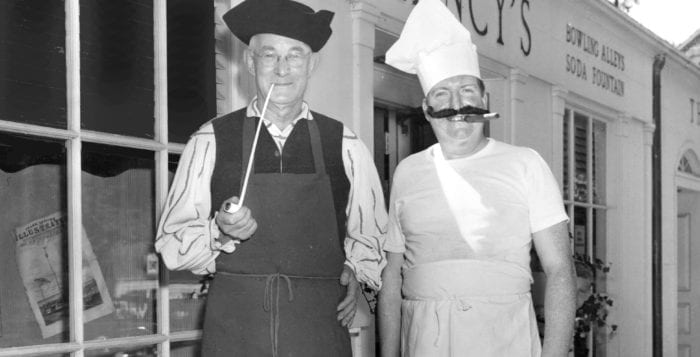SOLES for All Souls Run/Walk All Souls Church, 61 Main St., Stony Brook will hold its 8th annual SOLES for All Souls 5K Run/2K Walk on Sunday, Oct. 2 at 9:30 a.m., rain or shine. Proceeds from the event will help fund the maintenance of the historic chapel and church outreach events to the community. All preregistered runners and walkers are guaranteed a commemorative T-shirt. A postrace award ceremony will be held in the parking lot behind the church immediately after the event. Registration is currently underway through the www.active.com website, and there is a special discounted rate for participants under 19 of $10/person. For more information, call 631-655-7798.
Stony Brook
Local fun fact
By Ernestine Franco
The heroes of Greek and Roman legends are long gone, but they are still an echo in our collective mythic memories.
Hercules was the Roman name of the greatest hero of Greek mythology — Heracles. Like most authentic heroes, Hercules had a god as one of his parents, being the son of the supreme deity Zeus and the mortal Alcmene. Zeus’ queen Hera was jealous of Hercules and was determined to make trouble for him by making him lose his mind. In a confused and angry state, he killed his own wife and children.
The story goes that when he awoke from his “temporary insanity,” Hercules was shocked and upset by what he’d done. He prayed to the god Apollo, also a son of Zeus. As part of his punishment, Hercules had to perform 12 labors including slaying the Nemean lion — feats so difficult that they seemed impossible. Fortunately, Hercules had the help of some sympathetic deities. By the end of these labors, Hercules was, without a doubt, Greece’s greatest hero.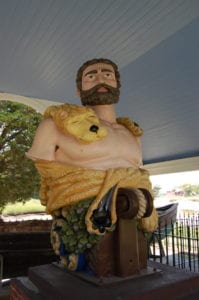 His struggles made him the perfect embodiment of an idea the Greeks called pathos, the experience of virtuous struggle and suffering that would lead to fame and, in Hercules’ case, immortality.
His struggles made him the perfect embodiment of an idea the Greeks called pathos, the experience of virtuous struggle and suffering that would lead to fame and, in Hercules’ case, immortality.
There have been many reincarnations of Hercules. To name just a few: Agatha Christie’s detective Hercule Poirot; the 1997 animated Disney movie “Hercules”; the TV show “Hercules,” which ran from 1995 to 1999; and a 1970 B film “Hercules in New York.” There is even an adjective, herculean, that embodies all the positive aspects of this hero.
But before all these, there was the 19th-century figurehead Hercules of the USS Ohio. Built between 1817 and 1820, she was the first ship built at the Brooklyn Navy Yard. The Ohio served in the Mediterranean, sailed the Pacific and landed troops on the shores of Vera Cruz during the war with Mexico in 1847. By 1884 the Ohio was decommissioned, sold for scrap and moored in Greenport. She broke free of her mooring during a storm and sunk a short distance off shore. Resting in a mere 20 feet of water, part of the ship was above sea level. The exposed parts of the Ohio were burned and the rest abandoned. Luckily this piece of folk art was stripped off the ship before her end.
The figurehead of Hercules, wrapped in the skin of the Nemean lion, was carved out of a single piece of cedar at a cost $1,500. At one point it was sold for a mere $10 at an auction. It was again sold for $15 by the then owner of the Canoe Place Inn in Hampton Bays where it remained for decades. Eventually the figurehead was acquired by Ward Melville in 1954 who deeded it to The Ward Melville Heritage Organization for preservation.
As if this isn’t already an amazing enough piece of history, the pavilion also has a whaleboat used on Charles Hall’s final arctic expedition. The Hercules Pavilion is located along Main Street in Stony Brook Village, across from the Village Green, near the anchor of the USS Ohio.
For more information, call 631-751-2244 or visit www.wmho.org.
Remembering Rebecca Lynne Weissbard: A Gold Medal equestrian’s legacy
"Ride for Becca" foundation created to help promising equestrians
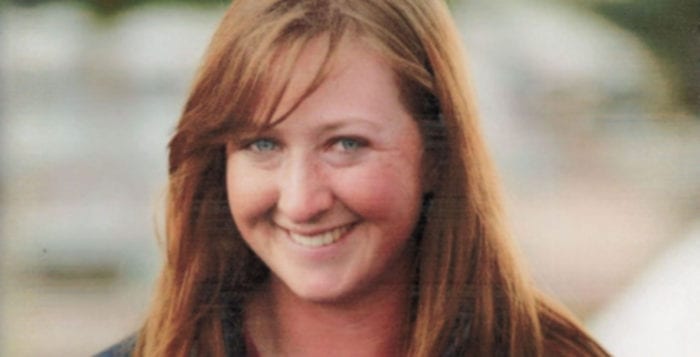
Gold Medal-winning, 22-year-old equestrian Rebecca Weissbard died Aug. 31 in Saugerties, New York, when her horse accidentally fell on her during a jumping competition.
Her father Eric and her mother Lynne plan to honor their daughter’s memory by establishing a nonprofit for talented riders to help them fulfill their dreams, he said in a telephone interview. Acknowledging the fact that it is an expensive sport, their goal is to provide financial help to working-class kids who show potential and share Rebecca’s passion for horses.
Becca, as she was known, died instantly. “It was quick,” her father said. “[The paramedics] tried their best, but nothing could be done.”
She was participating in one of the largest horse shows in the country, called HITS-on-the-Hudson. Becca and her mother were in upstate New York, and her father was home on the North Shore, serving a shift as an EMT with the Stony Brook Fire Department.

“She was such a dignified and well-put-together young woman,” Eric Weissbard said. “She wanted to be the best — to do it properly. She lived her passion and her dream. She worked hard and excelled. It is only fitting that we help other kids pursue their dreams.”
Her grandmother, Rochelle Weissbard, remembered Becca being around horses practically from birth.
“Rebecca was on a horse when she was a few months old — on her mother’s back; on her father’s back,” Rochelle said. “When she was two Lynne went back to training riders at Smoke Run [Farm] in Stony Brook and she took Becca with her. Right from the beginning she was a natural — and fearless.”
Raised in Stony Brook, Becca attended William Sidney Mount Elementary School through sixth grade. Her parents established Sundance Stables in Medford in 2003 but soon outgrew their rented barn and relocated the stable to Manorville.
“Rebecca was the welcoming, cheerful pied piper of the kids,” her grandmother said. “Wherever she was there was love and there was joy — and silliness — but when she was ready to ride, she’d take care of business. And she did. When focused, there was no one better. She rode to win.”
The grandparents have long supported the quadrennial Maccabiah Games held in Israel that bring together Olympic-caliber Jewish athletes from around the world. Traditionally held the year following the Summer Olympic Games, they are sanctioned by the International Olympic Committee and the World Federation of Sports.
As she became more and more proficient at the sport, Becca’s grandfather, Richard Weissbard, realized there were no equestrian events at the games. He contacted the director to ask why. That was about five years ago. The director said he’d get back to him.
The next Maccabiah Games — in 2013 — included equestrian events. Becca trained with Olympic equestrians Neal and Elisa Shapiro at Hay Fever Farm in Robbinsville, New Jersey, for several years. Neal Shapiro was the coach of the American Equestrian Team, which had 38 athletes. Becca won the first gold medal awarded in individual competition, which also helped the team earn silver overall.
The team members had to compete riding Israeli horses because the expense of bringing their own horses was too great. That was problematic for Becca considering, as her grandparents described seemingly in tandem, the horse she ended up with was “defective.” They said it actually went lame the day before the competition.
Very upset, Becca called her mother to find out what to do.
“She wanted to be the best — to do it properly. She lived her passion and her dream. She worked hard and excelled.”
—Eric Weissbard
“You march in there and you tell them you don’t care where they get a horse — just get one!” According to the grandparents, Becca practiced with a reserve horse for about two hours before winning the competition.
“She flew with him,” Richard Weissbard said; “…because she’s been around horses all her life,” her grandmother added. “We were so proud.”
At the games in Israel the then 19-year-old made connections that provided her with European opportunities.
“Wanting to go where the best horses are she chose to go to Holland,” her father said.
Becca worked at a horse stable in Holland for eight months. Her father said she learned a lot about top-tier horses and established a relationship with one particularly difficult horse. She made riding him look easy.
Labor laws for foreign workers dictated a return to the U.S., but a year later she returned to the Dutch farm for another three months. She’d fly back and forth as an escort for horses.
“In those 22 years she crammed in an awful lot of stuff,” her grandmother said. “But most of all she was a wonderful daughter, a great granddaughter, a terrific niece, and everyone who knew her loved her. Wherever there was excitement, there she was. Never a dull moment. She brought laughter and cheer and happiness and joy to everyone. She will be sorely missed.”
The Weissbards are setting up a foundation called Ride for Becca. “It will be a 501(c)3 nonprofit with the goal of helping kids who have potential to get to the next level,” said Eric Weissbard. “We want to find kids who are good and get them good training and get the horse good veterinary care.” They plan to keep Becca’s spirit and passion alive by helping others.
Once the 501(c)3 is established, tax-deductible contributions made out to Ride for Becca may be sent to Sundance Stables, 37 North St., Manorville, NY 11939.
Long Island Museum to host James Maddock concert
Americana and folk
The Long Island Museum, 1200 Route 25A, Stony Brook will welcome singer/songwriter James Maddock in concert on Sunday, Sept. 18 at 5 p.m. as part of the museum’s Sunday Street Series.
British born James Maddock was first recognized in the U.S as leader of the band Wood whose song “Stay You” was included in the first Dawson’s Creek compilation. After taking an extended break from record making, Maddock moved to New York City and returned to the scene in late 2009 with the exquisite collection of songs, Sunrise On Avenue C. Maddock followed “Sunrise” in 2011 with Wake Up and Dream and his last album, Another Life, was was frequently mentioned on “Best of the Year” lists for 2013. WFUV and Sirius XM host Vin Scelsa says “Maddock’s talent has a timeless quality he shares with the great songwriters. His music touches the soul.” His live performances show Maddock to be one of the most engaging and exciting artists on the acoustic music scene. Chris J. Connolly will open the show.
Advance sale tickets may be purchased at www.sundaystreet.org for $25 through Sept. 16 with remaining tickets at the door, if available, for $30 (cash only). The concert will take place in the Gillespie Room located in the Carriage Museum. The Sunday Street Series is a not-for-profit series sponsored by the collaboration of WUSB-FM, The Greater Port Jefferson Arts Council and The Long Island Museum. For more information, visit www.sundaystreet.org or call 631-632-1093.
Landmark status for Stony Brook’s Jazz Loft
The following is an edited Town of Brookhaven public comment presentation made Sept. 1.
Good evening, Mr. Supervisor and town board members.
My name is John Broven, author of three books on American music history. I am privileged to live in a historic district of East Setauket, part of the beautiful Three Village area. My late father-in-law, Clark Galehouse, founded Golden Crest Records out of Huntington Station in 1956 and released many jazz albums among others — I think you know where I’m coming from.
I fully endorse the recommendation of Town Historian Barbara Russell and the Historic District Advisory Committee to accord The Jazz Loft building at 275 Christian Ave., Stony Brook, landmark status. I would like to read my historical notes in support of my position.
The Jazz Loft building, in fact, consists of two historic structures: The Stone Jug and the 1921 firehouse. The building accommodated the first museum in Stony Brook, founded in 1935 by real estate broker and insurance agent O.C. (Cap) Lempfert, a keen hunter and taxidermist. At first, the museum was located in the home of Arthur Rayner where Saturday nature talks for children became a weekly event; naturalist Robert Cushman Murphy, of R.C. Murphy Jr. High School, led some of the nature walks.
Originally called the Suffolk County Museum of Natural History, it became known as the Little Museum in the Jug after it was moved to the Stone Jug storage building — a former tavern and social center of the village — with the backing of Mr. and Mrs. Ward Melville. The museum was formally incorporated as the Suffolk Museum in 1939.
You may be amused by a quote from a history of the Museums at Stony Brook, a later name before it became today’s prestigious The Long Island Museum: “The move was no small task since by that time the collection include a 400-pound loggerhead turtle, an eagle with a 6-foot wingspread, a trumpeter swan, and hundreds of small collection items.”
I am aware that Mr. Lempfert’s granddaughters, Mary and Jane L’Hommedieu, who both now live on the West Coast, are delighted at the town’s potential recognition of their grandfather’s museum building — and thus his pioneering work. Jane tells me he also made and exhibited duck decoys, collected Native American artifacts from his property for the museum and even constructed a wigwam. A major achievement of the museum to this day was to collect and show the fabulous paintings of William Sidney Mount.
It is wonderful that the building has come alive this year after careful restoration as The Jazz Loft incorporating a museum — how appropriate! — live jazz and education facilities. What Tom Manuel, a talented jazz musician, educator and historian, his board and The Ward Melville Heritage Organization have done to date is very impressive, not only for the Three Village area but also for Long Island tourism — and jazz itself. I know Supervisor Ed Romaine (R) and Councilwoman Valerie Cartright (D-Port Jefferson Station) attended the opening. By granting The Jazz Loft building landmark status, in effect the town will be protecting and preserving our past, present and future heritage. I trust the town board will support its Historic District Advisory Committee because I consider all the historical and cultural boxes have been ticked.
The result: A unanimous vote in favor.
John Broven is a member of the editorial staff of this newspaper. He gives thanks to Joshua Ruff, director of collections and interpretation of The Long Island Museum, for providing historical detail by way of “The Carriage Museum” (1987) publication.
Throwback Thursday
Blast from the Past:
Do you know where and when this photo was taken? Why are these men wearing costumes? Email your answers to [email protected]. To see more wonderful vintage photographs like this, visit The Ward Melville Heritage Organization’s ongoing exhibit, It Takes a Team to Build a Village, at The WMHO’s Educational & Cultural Center, 97P Main Street, Stony Brook. For more information, call 631-751-2244.
Last week’s photo:
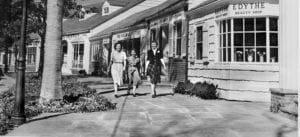 This photo was taken in the early 1940s in the Harbor Crescent section of the Stony Brook Village Center. Photo courtesy of The WMHO
This photo was taken in the early 1940s in the Harbor Crescent section of the Stony Brook Village Center. Photo courtesy of The WMHO
Photo of the Week
No catch and release here:
Karen Silvestri of Melville recently captured this image of a juvenile black-crowned night heron fishing for its next meal at Avalon Park and Preserve in Stony Brook.
Send your Photo of the Week to [email protected].
Host Family program benefits students and hosts

By Wenhao Ma
One local organization is helping international students adjust to American life.
An evening reception was held at the Wang Center on the Stony Brook campus Aug. 25 to introduce new international students to their host families. For 40 years, the Stony Brook Host Family Program has been providing opportunities for international students to learn about America by having them develop relationships with local volunteer families.
“It’s very difficult when you are not really comfortable with the language,” said Rhona Goldman, director of the program. “This [program] gives students a chance — off campus — to relax and interact with a family.”
Students do not live with the families, but they are invited to join them for meals or to attend events together. Goldman said some families meet with their hosted students two or three times a year, while others see each other on a regular basis.
Goldman and her husband, Dick, are hosting two new international students this year, one from Ghana and the other from China.
“There are so many international students,” Dick said. “They come in not knowing anyone. So they will gravitate to people from their own countries. The dorms, classes, study groups — everything turns out that way.”
He said a lot of international students have a difficult time adjusting to the culture. For example, they don’t know how to get a driver’s license or open a bank account. A family can ease the transition and make finding their way a much more pleasant experience, he said.
“Rhona and her husband Dick are wonderful,” said Jianing Yan, a former hosted student of theirs who graduated in May. “They helped me adapt to the life in America. They took me to shopping malls and grocery stores on the very first day I arrived. Also they helped me learn about the American culture … They really make me feel comfortable here. To me, they are my family.”
Goldman said the students are not the only ones who have benefited from the program. The families benefit, too.
David Altman became a volunteer last year. He hosted three students last semester and will host another two this fall. He said that he has traveled with his daughter to many countries and is interested in different cultures.
“I’ve studied many languages myself,” Altman said. “I know a little Chinese. [The program] helps me also. So it works both ways.”
The host family program works with the university to send out a notification to all international students after they have been admitted. To become enrolled in the program, both students and host families need to submit applications. Goldman said she matches students with families that share similar interests.
On average, about 120 students a year are assigned to 65 local families. However, according to Goldman, this year many students could not be placed simply because there are not enough hosts. She encourages families to learn more about the program and consider becoming hosts.
“We want to serve as many students as possible,” she said. “It’s a most rewarding program.”
Stony Brook homeowners rally to save their trees
Brookhaven highway dept. says it will take a second look before removal
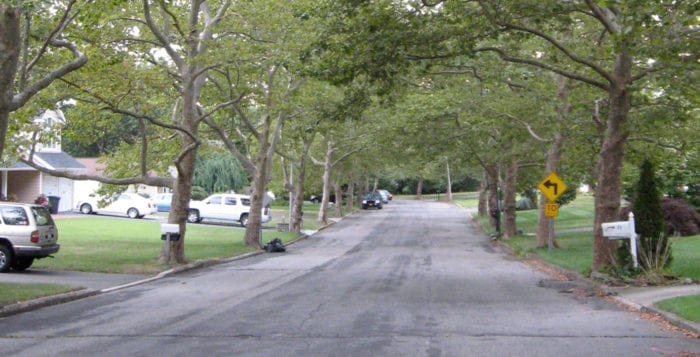
Two weeks ago, homeowners on Mosshill Place in Stony Brook were alarmed to find virtually every tree on their street — mostly sycamores — marked with pink dots. It came as a surprise — and a shock, according to Susan Ackerman, who feels the trees add so much to the neighborhood. She immediately called the office of Highway Superintendent Dan Losquadro (R) to inquire about the dots and said she was told they marked trees to be removed prior to road paving.
Ackerman said panic set in for her and her neighbors as they began to discuss the possibility of losing all the trees on the street and the ramifications that would follow.
“We didn’t know where to turn,” Mosshill Place resident Tom Caputo said. “Someone suggested we call News 12. Maybe if we got the story out, we’d get some help. We were surprised. [News 12] was down the next day and they brought Dan Losquadro.”
Ackerman said a paving project several years ago that resurfaced several of the “major” roads in the neighborhood — including Manchester Lane, Millstream Lane, Marwood Place, Millbrook Drive and Malvern Lane — was completed without the removal of any trees. She did not understand why the same process could not be used now.

For his part, Losquadro said he is just trying to do his job the right way.
“I have an extreme backlog of paving work, more than $100 million,” he said in a phone interview. “With an average annual budget of $15 to $18 million, I need to get the maximum life expectancy out of the roads I am paving. I have to make sure roads are done properly.”
Decades ago, there was no thought given to what species to plant and where to place the trees, Losquadro explained. As a result, the trees are right on the curbs, their roots intertwined with them. The superintendent said the tree removal is going to be a big expense, and he wished he could spend that money on road paving.
On her way to work, Ackerman said, she drove around the M section of the Strathmore Levitt houses in Stony Brook to tally the number of spray-painted dots on trees. By her count nearly 300 trees are tagged. She estimates that approximately 200 homes will lose trees.
In a letter to Losquadro resident Barbara Caputo listed a few of the benefits of trees she feels ought to be considered. Moderating heating and air conditioning costs, enhancement of property values, use by wildlife for food, shelter and nesting, and improving air quality and reducing pollution are among the reasons she listed trees help the community.
Losquadro said he had not planned to contact residents of the M section until he had assessed the situation, but the pink marks were noticed and homeowners are concerned.
In an Aug. 26 letter to affected residents Losquadro wrote, “Despite the markings you have seen, my staff and I are currently re-evaluating which trees must be removed to eliminate road obstructions and which can remain with repairs made to cracked or lifted curbing.” It went on to say that letters to all affected residents would be sent out shortly detailing the new recommendations.
Marian Guralnick is the original owner of a home on Mosshill Place.
“I’ve watched these trees grow for 50 years,” she said in a phone interview. “To lose them now that they form an aesthetically pleasing and beneficial canopy would be an ecological disaster.”
U.S. Sen. to wireless service providers: fix LI ‘dead zones’

Frustrating dropped calls, undelivered text messages and slow loading web pages may soon be a thing of the past on Long Island if one U.S. Senator has anything to say about it.
U.S. Sen. Chuck Schumer (D-NY) submitted a list to wireless carriers of more than 200 ‘dead zones’ for cellular service on Long Island Aug. 25. The list was accumulated by Long Island residents identifying areas where frequent lapses in service occur to Schumer’s website over the course of several months. North Country Road in Port Jefferson and Setauket, Main Street in Northport, Route 25 in Smithtown, Shore Road in Mount Sinai and Hawkins Avenue in Stony Brook were among the North Shore locations residents pegged for spotty service according to a press release from Schumer’s office.

“When it comes to cell service on Long Island, these dead zones are proof carriers need to —quite frankly— raise the bar,” Schumer said in a statement. “A heavily populated region like Long Island shouldn’t be home to over 200 dead zones. Just a stone’s throw away from New York City and home to several universities, thousands of businesses and more, Long Island’s cell phone coverage must remain uninterrupted. Now that Long Islanders have submitted critical dead zones locations to my office, our wireless carries must make sure they are fixed. I will share these locations to carriers and am urging them to come up with a solution that meets the needs of both Nassau and Suffolk residents.”
Spokespeople from wireless carriers T-Mobile and AT&T did not respond to requests for comment regarding Schumer’s list. Andrew Testa, a public relations manager for Verizon Wireless’ northeast market, deferred questions regarding the Senator’s list of dead zones to international nonprofit CTIA — The Wireless Association, who has represented the wireless communications industry since 1984. CTIA spokeswoman Amy Storey declined to comment on behalf of any of their members, which include Verizon Wireless, AT&T, T-Mobile and Sprint.
One company addressed Schumer’s concerns.
“Sprint is committed to making sure Sprint customers have a great experience on our network and we’re investing to improve our coverage and reliability on Long Island,” company spokeswoman Adrienne Norton said in an email Aug. 26. “We share Senator Schumer’s goal of better service for Sprint customers and look forward to working with him to enact legislation that will reduce barriers to network deployment.”
Norton added that more Sprint cell sites, or towers should be expected on Long Island in the next nine months, which should improve service.
Schumer said lapses in cellphone coverage could create dangerous situations if GPS technology fails, and could deter business owners from setting up shop or tourists from visiting Long Island if problems persist. He called on wireless companies to come up with solutions to alleviate the issues.






